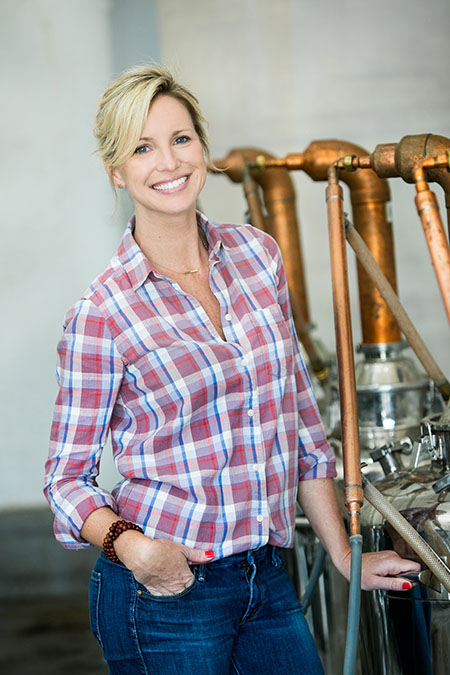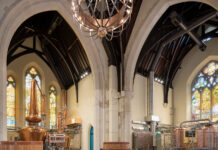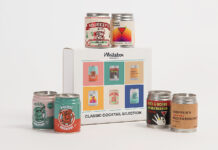
Photo Jessi Ringer
Born and raised in Laurel, Maryland, Jaime Windon is Maryland through and through, eventually going to college in Baltimore. But her experience — and her palate — were shaped by also living in San Diego, London, South America, Florida, D.C. and even Kenya for two years, an international perspective she’s brought back to her home state. Windon is president of the Maryland Distillers Guild and founded Lyon Distilling Co. (http://lyondistilling.com) with Ben Lyon back in 2012. But her drink knowledge started in bartending when she was a teen (or, rather, in those days she was a “beverage cart girl” at a country club).
The bar that first showed her “another way” — and which she calls “easily the best place I’ve ever worked” — was the now-closed Josephine’s in Fells Point, Baltimore. It was a neighborhood bar serving simple cocktails and beer, playing classic rock as a backdrop to lively conversation among regulars. Here, she learned about service, while other bars and restaurants taught her about food and wine, volume and obscure spirits. In Kenya, she dove into the joys of fresh juices.
Lyon and Windon first moved to St. Michaels in 2011, a small town on the scenic Chesapeake Bay, to manage a bed-and-breakfast but instead ended up opening a distillery, as they saw a gap amid other drink businesses in town. Passionate about the whole process, they source raw ingredients and rare grains and do all mashing, fermenting and distilling (in small pot stills) themselves. Lyon also brought perspective and experience from homebrewing to distilling.
While Windon ran business operations over the years, she only recently became more and more integrated in learning all aspects of the business, down to running the still. Since opening, she has grown in her love and knowledge of spirits across the board and even fills a much-needed gap in her small town of St. Michaels for elevated, culinary-inspired cocktails by throwing a classic cocktail pop-up bar, which she plans to host again in the future.
At Lyon Distilling, rum — in a number of iterations — is the star, and the distillery offers a range of excellent rums. They have grown to distill corn, rye and malt whiskeys in historic Maryland style, as well as a coffee rum and a stellar, balanced orange curaçao liqueur.
In her own words, Jaime talks about how she got into distilling, about running a distillery and what advice she would give to distillers seeking placement in bars.
Tell us how your distillery began…
Lyon Distilling began, like all the best things in my life, as a far-fetched, wild idea. My business partner, Ben Lyon, suggested we start a small distillery, and I thought he was crazy. However, I have a habit of saying “yes” to crazy, and I always leap at the opportunity to learn something new. More importantly, Ben had solid experience brewing and distilling on a small scale, and I have a long history on both sides of the bar: working in restaurants and bars across the country, and drinking across the globe. So we decided to go for it. The space found us first — a vacant building in a former flour mill in the historic redevelopment zone of St. Michaels. Ours is a small, coastal town on the Chesapeake Bay, home to less than 1,000 people, but with a craft brewery, small winery and working boatyard [already there], naturally, a distillery seemed like the missing piece. From there, we figured out the logistics as they came up. People are always surprised to hear that we had no business plan, no investors and no strategy. We just set out to do something that no one else around us was doing and to do it well. Ben is a spirits snob and I’m a perfectionist. We weren’t sure exactly what we were going to do, but everyone knew it would be great.
It’s important to mention that we absolutely did not start a distillery because we thought it was a good business idea. In fact, we didn’t initially envision the distillery as a business at all. It was a passion project, the act of selling spirits secondary to making spirits. However, we were immediately overwhelmed with the great response to our rums and spent every day of that first year struggling to meet demand in our tasting room, selling every bottle by hand, over the counter, selling out of every batch within days or hours of bottling.
We pulled all-nighters, enlisted the help of family and friends and steadily increased production. Eventually (after two years) we hired a few key people, invested in more equipment and increased production and distribution in Maryland and D.C. We are about to head into our fourth year and are incredibly excited to have more time, energy and a talented team to help us develop new products and see where this boozy journey leads us next.
What led you to distilling and spirits?
I’ve always enjoyed creating things — from art to cocktails — and distillation seemed like such an intriguing and obscure process. When I was tending bar, I knew a little about of lot of different spirits, but to really dive in and understand the fundamentals was very intriguing.
Starting a distillery was my business partner’s dream. Watching it develop, and growing it into a brand and a business, has become mine. The plan was for Ben to do all the distilling (back of the house) and for me to run the front, sales and tastings. However, as we grew from a two-person team and hired our first employees, I realized I wanted to know how to do everything, from start to finish. It started with fermentations, then stripping runs, proofing, blending. I’m still training my nose and palate to make those perfect cuts on the spirits runs.
We currently operate a truly nano-distillery with five 26-gallon pot stills. It’s tricky balancing the production schedule, planning the mashing and squeezing in whiskey runs alongside the rum. Often we run the stills 15–20 hours a day so it’s all hands on deck, seven days a week. I marvel at the fact that I have learned everything I know about distilling here in this building over the last three years.
What spirits do you consider your flagship spirits and how did you come about deciding to distill them?
Our flagship spirit is rum. We launched with rum — a raw, white spirit and a barrel-rested version — because we believe it is the most authentic American spirit. I love rum for its versatility. I literally make a rum version of every cocktail imaginable. I may not have been the first person to ever drink a rum Negroni, but it has now become a “thing” and I love that. #DRINKMORERUM is my motto.
Rum is truly a spirit that allows us to experiment and continually innovate. At the moment, we have five different rums and three rum liqueurs. At the base, Lyon rum is decidedly different than anything else out there: a blend of molasses and cane sugar, distilled twice in genuine pot stills to preserve the spirit’s inherent grassy, smoky, robust flavors. I’m incredibly proud to be one of a very few number of distilleries producing something you really couldn’t find a decade ago: a delicious, young, American rum.
How have you grown your brand as one of the pioneering craft distillers?
We take the term craft seriously. All of our spirits begin as intentionally sourced, raw ingredients, created by hand: mashed, fermented, double-distilled, proofed and barrel aged in house. For us, this is what it means to be truly craft.
Our goal is to create distinctly unique spirits — working to define the category of new American rum, while experimenting with a very small whiskey program. We mash in ultra-small batches (100 gallons) for corn, rye and malt whiskey. We are inspired by the balance of paying homage to the traditions of Maryland Rye Whiskey, while also experimenting with obscure grains and varied finishes for our American Malt Whiskey and others.
What advice would you give to fellow distillers looking to get their spirits into bars?
Spend time in bars! I’m often shocked when distillers tell me they don’t like to drink or enjoy going out to bars. One of my greatest joys is sitting down at a fabulous bar and being able to order one of our spirits in an inspired cocktail. Try everything — all the flavors, all the spirits, even those that you have no intention of making. You have to understand flavor and what is available out there in order to create something different and ideally better to grab the attention of a well-versed mixologist.
What spirits are exciting you most right now?
I often say my favorite thing is something I’ve never had before, which is one reason why I love being in this business and having the opportunity to craft my own spirits. Right now we are working on a series of rum-based infusions and liqueurs, and I feel like the possibilities are endless. For me right now it’s ROCK & RUM (http://lyondistilling
.com/2016/12/lyon-rock-rum), a slightly sweeter, smokier, richer twist on the beloved Rock & Rye. It’s basically my version of a Tiki/rum Old Fashioned — a cocktail in a bottle!
Tell us about your involvement with Maryland’s distilling guild and why being involved is important to you.
As one of the founders, and the inaugural president, of the Maryland Distillers Guild, I couldn’t be happier to have the opportunity to create a community for distillers and to promote the industry across the state. I am proud to have helped pass key legislation that is helping to grow all of our businesses and create a friendly environment for others who want to create spirits in Maryland. I love helping others achieve their dreams and am committed to making our state known (once again) as a home for superior spirits, especially rum and rye. I look forward to stocking my bar with more Maryland-made booze.








